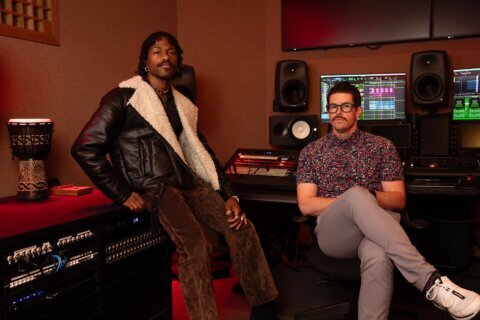In 1966, the Broadway musical won eight Tonys, including Best Musical.
In 1972, the movie version won eight Oscars, including Best Director for Bob Fosse, Best Actress for Liza Minnelli and Best Supporting Actor for Joel Grey.
Now, “Cabaret” turns Olney Theatre Center into the Kit Kat Klub until Oct. 13.
“This is a classic piece of musical theater,” lead actress Alexandra Silber said. “You will see beautiful costumes, hear a 17-piece orchestra, a perfectly cast version of this classic. … Not only will you be entertained, but hopefully also moved and most importantly galvanized to leave the theater and do something.”
Adapted by Joe Masteroff from John Van Druten’s 1951 play “I Am a Camera,” which was itself based on Christopher Isherwood’s 1939 novella “Goodbye to Berlin,” the show is set in 1931 Berlin during the rise of Nazi Germany. It explores the divinely decadent Kit Kat Club, where American writer Cliff Bradshaw falls for British cabaret star Sally Bowles amid the orchestrations of a ravishing Emcee.
“It basically is about the rise of fascism in the Weimar Republic,” Silber said. “‘Cabaret’ is a play about the price of complicity, the price of a neutral stance in an increasingly antagonistic world and an answer to the question: How did this happen? … When bigotry and hatred looms, what are you going to do about it?”
Ironically, Silber’s first encounter was not Minnelli, but Natasha Richardson.
“My first exposure was the 1998 revival,” Silber said. “It was the second Broadway show I ever saw. I was a 14-year-old in the mezzanine, profoundly moved / deeply scarred. … It was eye-opening. … You realize you’re being intoxicated, entertained and slowly creeping in with the social message.”
Likewise, co-star Mason Alexander Park said the 1998 revival was also his first exposure, meaning his first Emcee template was Alan Cumming, not Joel Grey.
“When I was in high school, I saw YouTube videos of it,” Park said. “I watched Alan Cumming’s version at the Donmar Warehouse … before it came to [Broadway]. They recorded the whole thing. It was pro-shot, it looked like it was for PBS or BBC. I remember watching it saying, ‘This is some of the best theater I’ve ever seen.’ It was dark, twisted and something I wanted to be a part of.”
He loves that the Emcee is detached from the story as the show’s conscience.
“He’s a very elusive, weird, creepy, androgynous person that tries to bring the audience in like a ghostly narrator,” Park said. “The emcee is both within the story but also provides commentary on things that are happening socioeconomically and politically at the time. The Emcee gets to be this conduit as to what was happening in Germany and what’s happening in the story. … So, it gives you a lot of freedom to play with different colors in your acting and vocal coloring book.”
Indeed, the Emcee laces his charming showmanship with underlying warnings.
“The Emcee functions as a contemporary political cartoon / late-night comedian, the satirist that takes liberties to explain and comment upon what is happening sociologically,” Silber said. “At one moment it’s lighthearted, then suddenly it can no longer be. You’re seeing a really beautiful world, [a club with] a very expensive entry fee, and something you’re very sad to see decay.”
Director Alan Paul and scenic designer Wilson Chin present a rear wall mirror, giant red drapes and six chandeliers loaned by the Washington National Opera.
“Aesthetically speaking, all of the designers heavily researched a lot of dance halls and cabarets that were a little more decadent, upper class,” Park said. “You can easily get sucked into the beauty of it all. … It’s very enticing, so you forget what you’re watching because you’re seeing these beautiful decadent costumes. … You’re like, ‘Oh yeah, I’m watching a musical!’ That’s part of the structure of the piece, it’s meant to suck you in, then pull the rug out from underneath.”
Amid this backdrop, we get a biting songbook by John Kander and Fred Ebb.
“‘Money, Money’ and ‘Maybe This Time’ were both actually added to the film in the 1970s; they weren’t in the 1960s show,” Silber said. “Then of course the iconic song ‘Cabaret,’ which most people know the Liza Minnelli version. The opening number ‘Willkommen,’ ‘Two Ladies.’ There’s a lot of familiar songs.”
“One of my favorite songs to sing is another addition,” Park said. “It was written as street music during the first production where Sally and Cliff walk by a prostitute on the street corner who’s singing a song. It didn’t make it into the actual show, but they put it back into the Joel Grey revival in the ’80s. … They reintroduced it in the third revival. It’s definitely my favorite. It’s my swan song.”
As for Silber, her big stage moment is, of course, the title number.
“The title song feels like an empowering moment,” Silber said. “Sally is our anti-hero and in that moment we really see the ‘anti.’ … We see this woman who’s despicable but also irresistibly charming. We see her melt down and, with her, the world around her. It’s exhilarating to ride the roller coaster down with her.”
That roller coaster includes iconic dance movements by choreographer Katie Spelman and period wardrobe by costume designer Kendra Rai.
“We have all these beautiful stylizations,” Park said. “Instead of the usual Kit Kat girl in lingerie kind of vibe, it’s like we’re doing burlesque numbers, numbers in boats with feather fans and things. It feels very Kander and Ebb in that sense, because that hearkens back to ‘Chicago’ and so many visuals that I think of in musical theater. It’s very 1920s vaudeville. A very German vaudeville vibe.”
Even if you’ve seen past renditions, this latest version promises a timely take.
“Our version of the show is very special in that it doesn’t have to hit anything over the head in order to pack a punch,” Park said. “We’re allowing the audience to really listen to the words again in a way that just the world around you changing informs the way that you intake art and the way that you listen to things. … To do it now has a very different meaning than it would have four, five, six years ago.”
“We definitely confront the audience in the last 60 seconds,” Silber said. “It doesn’t beat you over the head with the historical aspects; it really does universalize and make contemporary how real this problem still is.”
Find more details on the theater website. Hear our full conversation below:







